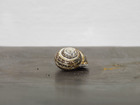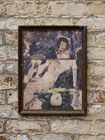As a series of new paintings that open a conversation with the gallery’s Georgian architecture and garden, the works in the exhibition acknowledge a debt to historical and contemporary self-taught painting in Australia and Manchester, while showing a gritty amalgamation of unmonumental abstraction and figuration. Influences include early renaissance artist Piero dela Francesca and the Scottish-born Australian painter-wanderer Ian Fairweather.
Two references for ‘A Clay Hand’ also include the famous Mancunian L. S. Lowry and the Australian Selby Warren, twentieth century artists notable for their depictions of working people and bush rangers. While Lowry is famous for scenes of life in the industrial districts of Northwest England, Warren was a ‘Bushman’ and rabbit trapper who began painting in earnest after his semi-retirement at the age of seventy-six, and is considered the grandfather of Australian ‘self-taught’ art. With these precedents, the works in this exhibition can be seen to connect nineteenth century industry with antipodean itinerance across continents.
Novel (2022) and Bedfellow (2023) – the first work’s title refers to the act of writing and painting through a few apparently casual or indiscriminate white marks on raw board, the second being made from one of the artist’s childhood bedsheets – could be described as small gestures with a different register of reflexivity or self-referential criticism to the work of artists such as Michael Krebber. Instead, these fragile paintings have a direct or emotional content. As Hartigan has said: ‘they’re not so much reductive or minimal as subliminal’. If these works present an unassuming quality, we might reconsider Raphael Rubenstein’s text ‘Provisional Painting Part II: To Rest Lightly on Earth’ from 2012: ‘whether it looks easy or arduous, the provisional work is always opposed to the monumental, the official, the permanent. […] It wants to hover at the edge of nonexistence. It wants to rest lightly on the earth.’
It’s clear that Hartigan is interested in revitalization and entropy in nature and painting, stating: ‘with these works, it felt like I was planting, digging, clearing, and unburying; it was a bit like hunting for fossils or working in the garden. I kept thinking about the word “Garden”.’ Each work can be viewed on this level: materiality on the one hand, nomadism, strata, and renewal on the other. As a nod to this, Hartigan has decided to take part of the exhibition outside of the gallery, with A Light Wind and Harem (both 2022) hanging on the walls of the gallery courtyard.
Messenger (2022), in contrast, presents us with an image of a goblin, a playful sprite that runs through the picture frame in a sinister manner, at the beginning of the exhibition. Hartigan has said that many of his paintings develop from the corner of his eye, revealing themselves slowly over a particular period. This is certainly true of Valley of Kings, a collaborative work made with the Australian sculptor Hany Armanious. The artists’ ongoing dialogue is important for them both, as is the innate social aspect to collaboration that reveals itself through a pulling forward of imagery, rather than a projection of it.
— text by Andrew Hunt



































